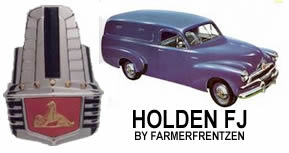 A DINKY-DI
Australian icon, the famous FJ is perhaps the most fondly
remembered of all the early Holdens. Today, the sight of its
big, bold, familiar front grille has the power to transport
nostalgic baby boomers back to that fabulous era when the
fifties stood for rock 'n roll and not your age group.
A DINKY-DI
Australian icon, the famous FJ is perhaps the most fondly
remembered of all the early Holdens. Today, the sight of its
big, bold, familiar front grille has the power to transport
nostalgic baby boomers back to that fabulous era when the
fifties stood for rock 'n roll and not your age group.
The bond could go even deeper, according to social historians,
because many of those boomers may well have been conceived in the
back seat of an FJ Holden. The first car that many ordinary
Australians had ever owned, it sold in unprecedented numbers and
offered an equally unprecedented degree of mobility, freedom and
privacy. The FJ became an enduring symbol of the Aussie way of
life, serenaded in song and awarded the distinction of the title
role in a feature-length movie.
Essentially a face-lifted version of its predecessor, the FX or
48-215 model, the FJ's main external distinguishing features were a
torpedo-style tail light and the horizontal, American-influenced
chrome grille with twin port 'nostrils' - a distinctive Holden
characteristic later echoed in the strong hood design of the VR, VS
and VT Commodore models.
In tune with the times, which saw post-war austerity overtaken
by the growth of the consumer society, the FJ ushered in the first
de luxe Holden, the Special, adding a pampering touch to the
brand's straightforward virtues of value for money, durability and
impressive performance. Instantly popular, the Special sported more
bright metal body decoration, including tiny tail fins with
built-in reflectors, and offered such enticements as leather trim,
armrests, cigarette lighter, rear passenger assist straps, chrome
window winders and gee-whiz two-tone colour combinations.
"From every angle," read the sales brochure, "Holden Special is
a graceful beauty." Headlined as 'Australia's Own Car' and splashed
with golden wattle, the brochure also extolled the virtues of the
more spartan Standard model, praised for its six passenger
roominess, family-sized luggage compartment and PVC upholstery -
"...a recently developed plastic coated material with exceptional
durability and a finish simulating antique leather." The Business
sedan was aimed at the commercial market and "specially equipped to
meet the particular needs of business and country users whose
vehicles are engaged in heavy work or are located in arduous
country."
A utility was also offered, and the first Holden panel van made
its debut two months after the FJ's October 1953 launch.
Utility-based, with an extended roof and an extra upper tailgate,
the panel van found ready acceptance in a booming market, which saw
eager consumers snap up the new Holdens at record rates and
entrench GMH in the number one sales position.
By 1954, FJ Holdens were being produced at assembly plants
nationwide at the rate of 250 per day - not nearly enough to
satisfy demand. The same year, however, GMH took the decision to
ship FJs to New Zealand "in the national interest", beginning an
export drive that by 1956 saw Holdens on the road in Thailand,
Malaya and North Bomeo. GMH celebrated the production of the
250,000th Holden, an FJ, in January 1956. It had taken the company
just over seven years to produce its quarter millionth car - and
the magic million mark would be reached only six and a half years
later.
- Year of Introduction: 1953
- Engine: 2.15 litre or 123.5 cu.in. 6 cylinder
- Power: 45kW or 60bhp
- Transmission: 3 speed manual
- Performance: 0 - 100 km/h 20.0 seconds; Standing 400
metres 20.5 seconds
- Production: 169,969
- Price: $2,046
WP1 - At the coordinates given above you will find a 5 digit
number at ground level (ABCED). The location of the next waypoint
is calculated as follows:
S 35 (A)(A+D).(C-E)(A+C)(B)
E 149 (B)(D+3).(A)(C+2)(E+8)
WP2 - At the next location you will find a 5 digit number at a
height of about 6ft (GFHIJ). The final location is calculated as
follows:
S 35 (F)(H).(I-F)(F+G)(J)
E 149 (F-1)(J).(H)(H+G)(I+G)
The cache is a small Tupperware type container with a grey lid.
Please rehide it so that it is not too obvious!
*****FTF-Sol de lune & AusCan1965*****